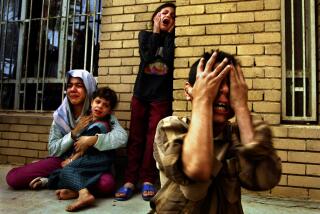Repairing for another tour of duty
- Share via
LEMONT FURNACE, PA. — Dozens of military vehicles plucked from the battlefields of Iraq stand idle and partly dismantled outside a rural Pennsylvania plant, awaiting mechanics, welders and painters who will prepare them for another tour of duty.
The Bradley Fighting Vehicles, stripped of their treads, scarred and simply worn down from being driven long miles in harsh desert conditions, are the latest of hundreds refurbished or upgraded annually by their maker, BAE Systems -- one of many defense contractors whose business has grown throughout five years of fighting in Afghanistan and Iraq.
BAE Systems has seen its Bradley business double since the start of the war in 2003, and like many defense companies, is poised to benefit further from soaring government spending as the military replaces, repairs or upgrades combat equipment used in Iraq and Afghanistan.
Last year, the military began shipping thousands of battered Humvees and other pieces of equipment -- including helicopters and tanks -- from Iraq to the United States to be rebuilt.
Another major defense contractor, General Dynamics Corp., has been awarded contracts to overhaul hundreds of its Abrams tanks since 2004, said Tom Peterson, the company’s M1A2 Abrams program manager. It has also established a major repair depot in the Middle East for its eight-wheeled Stryker troop carriers.
Other defense companies doing refurbishment work include Boeing Co., the Chicago-based maker of Apache and Chinook helicopters; Lockheed Martin Corp., the Bethesda, Md.-based F-16 fighter jet manufacturer; and L-3 Communications Holdings Inc., a New York-based maker of specialized communications systems.
BAE Systems was already refurbishing or upgrading the vehicles, built from 1981 to the mid-1990s, before the Iraq war began, but the fighting has brought a big increase in the number of Bradleys that need fixing or improving. The Army has about 4,500 of the vehicles.
The work largely entails basic automotive repairs: rebuilding diesel engines, transmissions and suspension systems. Relatively few show signs of combat damage. Andy Hove, director of the company’s Bradley Combat Systems division, said a typical Bradley might have been driven 800 to 1,000 miles a year before the war, but might cover as many as 10,000 miles a year in Iraq.
As a result, they need to be refurbished more frequently. “It’s routine work, but instead of seeing these vehicles every 10 years, we’re starting to see them every one year,” he said.
This warehouse-size plant about 40 miles southwest of Pittsburgh has been receiving as many as 500 Bradleys annually from an Army depot in Texas. The company later sends them to a larger BAE Systems facility in York, Pa., for reassembly and testing.
Inside the Fayette County facility, a roof-mounted crane lifts a gun turret out of a Bradley and gently carries it to another part of the floor. Workers crawl around the aluminum shells of some vehicles, drilling fresh holes or welding on brackets that eventually will hold new equipment. Some Bradleys are still clad in thick steel armor.
Like many employees at the plant, Joe Snyder has military experience. An Army National Guard reservist, he was deployed to Iraq for about nine months in 2005.
“I know where these vehicles are going and I know what they’re going to be put through,” he said.
Some vehicles carry traces of the troops who rode in them. Spent shell casings often are found under floorboards. Compasses, soda cans and sunglasses also have been discovered in the vehicles’ recesses.
“Occasionally, we get little notes,” said Deborah Fox, the plant’s manager. “We found a wedding ring once and sent it back to the government, and they got it back to the guy.”
A message scrawled inside one vehicle appears in a photograph at the facility: “This Bradley saved the lives of six soldiers from C/116th in Ft. Riley, Kansas. This Bradley struck an anti-tank mine and proved itself as a savior.... “
The Bradley overhauling and remanufacturing businesses totaled about $1.4 billion in 2006 compared with $500 million to $800 million in prewar years. The firm’s London-based parent, BAE Systems, had 2005 sales of more than $28 billion.
Government spending on military operations in Iraq and Afghanistan in 2007 is expected to reach its highest level since the Iraq war began, possibly growing to as much as $200 billion. About $120 billion was spent in the 2006 budget year, according to the Congressional Budget Office.
“We’re getting into that cycle now where all that equipment over there is breaking down and needs to be refurbished,” replaced or upgraded, said Stephen Trimble, Americas bureau chief for the defense industry magazine Jane’s Defense Weekly.
“It starts getting really pricey, and companies have been making a lot of money doing this,” Trimble said. “It’s certainly something that for the next few years is going to be nice for their bottom lines.”
More to Read
Sign up for Essential California
The most important California stories and recommendations in your inbox every morning.
You may occasionally receive promotional content from the Los Angeles Times.










